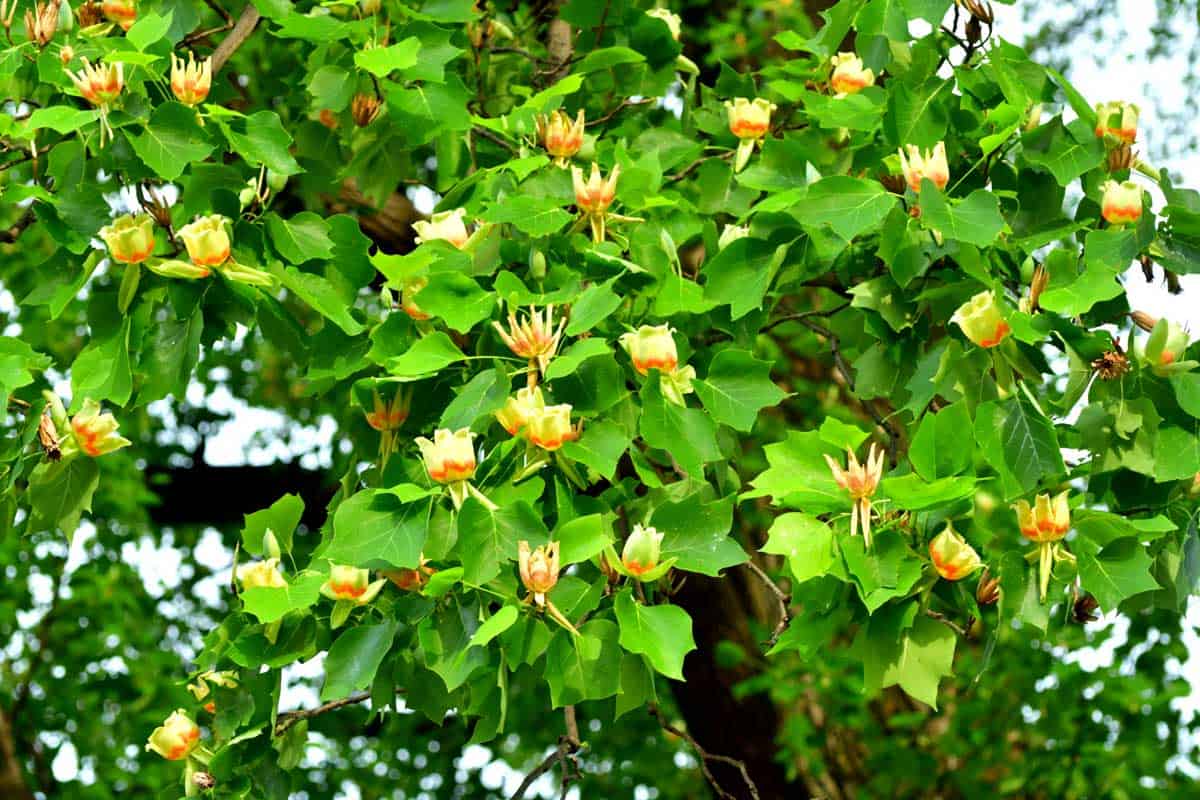Believe it or not, tulip trees technically are not tulips! They are large deciduous trees that belong to the magnolia family. If you're in search of a beautiful shade tree, this may be the one for you.
![What Is a Tulip Tree? [Inc. Examples and Care Tips]](https://gardentabs.com/wp-content/uploads/2020/02/What-is-a-Tulip-Tree-Inc-1.jpg)
The tree blooms in May and June, providing you with gorgeous flowers. The blooms measure between 1.5 and 2 inches, with greenish-yellow petals and a bright orange center. In the center of each flower is a cone-shaped seed cluster. Their glossy green leaves measure between 4 and 8 inches and slightly resemble the shape of a tulip leaf. During the fall, they'll turn to brilliant golden hues. The tree can reach just about 100 feet in height and spread to around 40 feet in width.
Continue reading to find out more about these incredible trees!
Botanical Background of Tulip Trees
How to Grow Tulip Trees

Follow along with the growing guide below to learn about the tulip tree's optimal growing conditions and how you can help it perform best.
Where It Grows
Due to the immense size of this tree, the best place to grow it is outside where there is plenty of room to accommodate its growth.
Size
Amazingly, this tree can grow to stand between 70 and 90 feet, and sometimes more! It can spread to around 40 feet. They're known for being quick growers, able to provide shade when they're rather young. During the fall, their foliage shows off with its glowing colors.
Prune the trees every once in a while to keep them well-shaped and to promote the health of the limbs. Considering the number of flowers it produces, be prepared to rake up their remnants after they fall.
Optimal Growing Zones and Conditions
Tulip trees are hardy in USDA plant hardiness zones 4 through 9, giving them an extensive range of areas in which they can grow. It's native to the northeastern United States, but can be grown in other regions.
These deciduous trees grow best in temperate climates, but they can tolerate slight droughts if the air is humid. Because it grows so quickly, be aware that its branches are more likely to succumb to harsher environmental conditions.
Type of Soil

The best types of soil for tulip trees are loamy and well-draining with lots of compost treatment. As long as the soil drains well and it has been treated with compost, the actual composition of the soil is of little consequence.
Light, Watering, and Fertilization Requirements
Tulip trees grow best under partial to full sun conditions. They'll perform best if they can receive 6 hours of sunlight each day. Water regularly during the hotter months and keep an eye on its leaves to determine its needed water supply. Younger trees benefit from fertilization, but as they mature, they will not require it.
Step-by-Step Growing Guide
- Plan to plant the seedlings between springtime and early fall
- Pick a spot that gets at least 6 hours of sunlight per day
- Dig a hole that's approximately the depth of the seedling's root base and one foot wider than it's original container
- Fill the hole, but don't stamp it down
- Add mulch around the tree mound to help retain moisture
- With young seedlings, you'll want to make sure that the roots get enough moisture and don't dry out
- Enjoy watching the growth of your tulip tree!
Inspirational Gallery of Tulip Trees
Check out this amazing gallery for some photo inspiration!
Stunning Blooms
Even Birds Love Them
Springtime Growth
Fall Foliage Interest
Line a Walkway
Tulip Tree Seedling
Immense Height
Family Resemblance
Springtime Color
Perfection![]() in Shape
in Shape
Bright Green Showoffs
Visual Appeal
Dissection of Leaves and Flowers
Flaming Tree
Statement Tree
Time to Purchase Tulip Trees
Whether you want to plant your tree from seed, seedling, or a 2-3 foot live tree, you'll find plenty of options here!
Tulip Tree Seedling
Tulip Tree Growing Kit
Click here to see more on Amazon.
2-3 Foot Live Tree
Click here to see more on Amazon.
More Reading
On the flowering tree note, check out Tree Peonies: Gardening Tips, Photos, and More.
If you want the look of a classic tulip, here's Where to Buy Tulip Bulbs [Top 40 Online Stores].
![What Is a Tulip Tree? [Inc. Examples and Care Tips]](https://gardentabs.com/wp-content/uploads/2020/02/What-is-a-Tulip-Tree-Inc.jpg)



